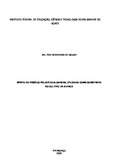Efeito do resíduo foliar da algaroba utilizado como substrato no cultivo da alface

Visualizar/
Data
2025-03-11Autor
Souza, Walton Bernardo de Souza
-
Metadado
Mostrar registro completoResumo
This study aimed to evaluate the effect of different proportions of leaf residue from the
legume and tree algaroba (Prosopis juliflora Sw.) on the composition of the substrate
for the growth of lettuce (Lactuca sativa L.), variety Elba, curly loose type. The algaroba
residue used is easily obtained locally, which can bring benefits to the production
system in the practice of ecologically based agriculture, while reducing costs and
mitigating impacts on the environment. The experiment was conducted in the
greenhouse of the Federal Institute of Education, Science and Technology of Rio
Grande do Norte (IFRN) in the municipality of Ipanguaçu-RN, from July 11 to August
31, 2023. The experimental design used was completely randomized, with 5
treatments (proportions of 0%, 10%, 20%, 30% and 40%) and five replicates. The
seedlings formed in trays, after 15 days of germination, were transplanted into pots
with a capacity of 3.5 liters, receiving daily watering with the same volume for all
treatments, with five randomizations performed each weekly cycle, during the
vegetative period. The harvest and data collection were performed at 51 days, 36 days
after transplantation. The data were subjected to analysis of variance by the F test and
the means compared in the Scott-Knott test at the 5% probability level. The results of
the experiment demonstrated that the variables plant height, stem diameter and
number of leaves increased from the proportion of 20% of mesquite residues, while
the chlorophyll concentration increased at 30 and 40%. The variable root length did
not show significance. The results indicated the possibility of using mesquite leaf
residue in the composition of substrate, with mineralization potential for soil enrichment
and a source of generating better sustainability for the farmer in the practice of organic
production. Furthermore, the use of mesquite residue can be used as biomass for
green manure or mulch, under field conditions.



